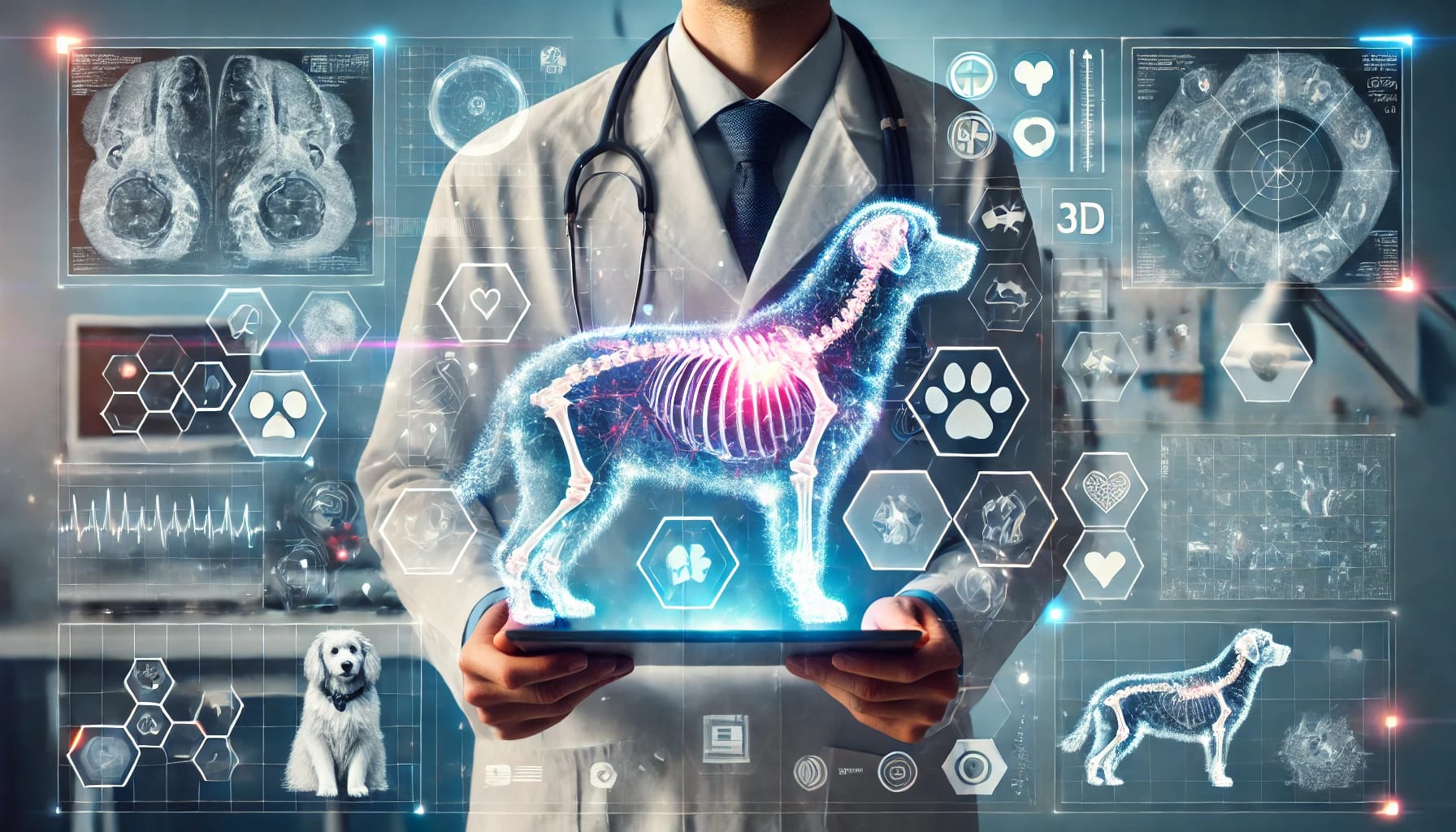


Bittsi Admin
February 28, 2025
9 Minutes Read
In This Article
Artificial intelligence (AI) is transforming industries worldwide, and veterinary medicine is no exception. From enhanced diagnostics to predictive analytics, AI-driven innovations are reshaping how veterinary clinics operate, improving efficiency, and enhancing patient care. As the industry embraces digital transformation, AI promises to play a pivotal role in veterinary healthcare, offering solutions that streamline workflows, optimize treatment planning, and elevate the overall client and patient experience.
AI adoption in human healthcare has accelerated in recent years, with machine learning algorithms enhancing diagnostics, treatment plans, and administrative workflows. The veterinary field is now following a similar trajectory, with AI being integrated into practice management systems, diagnostic tools, and even client communication channels
Many veterinary clinics today face significant challenges, including administrative inefficiencies, growing patient loads, and resource limitations. Traditional methods of managing patient records, appointment scheduling, and diagnostics often lead to time-consuming manual processes, increasing stress for veterinary professionals. Additionally, ensuring consistent patient care while maintaining financial sustainability is an ongoing struggle. AI-driven solutions offer the potential to alleviate these pain points by introducing automation, precision, and data-driven decision-making.
According to the American Veterinary Medical Association (AVMA), over 60% of veterinary clinics report that administrative workload affects their ability to focus on patient care. Common inefficiencies include excessive paperwork, delayed diagnostics, and miscommunication among staff members, all of which contribute to decreased productivity and increased burnout.
AI-powered diagnostic tools can analyze imaging scans, X-rays, and lab results with greater accuracy and speed than human evaluation alone. Machine learning algorithms can detect anomalies in radiographs and flag potential health concerns early, aiding veterinarians in quicker and more accurate diagnoses. Clinics utilizing AI-assisted radiology have reported a 25% reduction in diagnostic errors.
AI-integrated pathology systems can assist in analyzing tissue samples, reducing the time required for pathology reports while enhancing diagnostic accuracy. AI algorithms trained on thousands of pathology slides can quickly identify abnormalities, expediting treatment planning and improving patient outcomes.
Wearable AI-driven devices and remote monitoring tools allow veterinarians to track pets' vital signs in real time. These innovations enable early detection of illnesses and allow for more proactive healthcare management. AI-powered smart collars can track heart rate, temperature, and activity levels, alerting veterinarians to potential health concerns before symptoms become critical.
AI-enabled practice management software automates routine tasks such as scheduling, invoicing, and medical record-keeping. This significantly reduces administrative burden, allowing veterinary staff to focus more on patient care. AI-assisted appointment scheduling has led to a 30% reduction in client wait times and scheduling conflicts.
AI-powered chatbots and virtual assistants enhance client communication by providing instant responses to frequently asked questions, appointment scheduling, and post-visit follow-ups. This enhances the overall customer experience while reducing the workload on front-desk staff.
Personalized treatment plans generated through AI analytics help tailor medical care to individual pets. AI tools can assess past medical history and behavioral data to recommend optimal care solutions, strengthening the veterinarian-client relationship.
AI-driven remote monitoring systems allow veterinarians to track patient progress outside the clinic, reducing the need for frequent in-person visits and enabling continuous care for chronic conditions. For example, smart feeding devices can measure food intake and alert veterinarians to changes that could indicate underlying health issues.
The rise of AI-powered telemedicine platforms enables veterinarians to conduct virtual consultations, providing accessibility for pet owners and ensuring timely medical advice for animals in remote locations. AI chatbots can also triage patient symptoms, directing pet owners to the appropriate level of care.
AI simplifies record-keeping by automatically updating and organizing patient data, ensuring accuracy and easy retrieval of medical histories, prescriptions, and treatment plans. AI-powered voice recognition software can transcribe SOAP notes in real time, further reducing documentation workload.
AI algorithms analyze vast datasets to identify patterns and predict disease risks, helping veterinarians make informed decisions regarding preventive care and personalized treatments. Genetic analysis powered by AI can assess breed-specific health risks and recommend targeted interventions.
Predictive analytics can optimize clinic operations by forecasting patient influx, managing inventory more efficiently, and reducing unnecessary costs by minimizing waste. AI-assisted inventory tracking systems can alert clinics when stock is low and suggest reorder quantities based on historical usage patterns, reducing excess spending.
As AI takes on a larger role in veterinary medicine, ethical concerns regarding data privacy, patient autonomy, and decision-making responsibilities arise. Veterinary professionals must navigate these challenges carefully while maintaining trust with clients.
Implementing AI-driven solutions requires investment in technology, staff training, and system integration. Smaller clinics may struggle with the initial costs, making widespread adoption a gradual process.
Veterinary professionals must be adequately trained to understand and utilize AI-powered tools effectively. Ongoing education and adaptation to new technologies will be essential for maximizing AI’s benefits in clinical practice.
As AI technology continues to advance, veterinary clinics can expect even more sophisticated applications, including AI-assisted robotic surgeries, real-time diagnostic tools, and smart AI-driven decision support systems.
Rather than replacing veterinarians, AI will serve as an invaluable assistant, enhancing decision-making and improving efficiency. Veterinary professionals will be able to provide more accurate diagnoses, reduce manual workload, and focus on higher-level patient care.
AI will contribute to early disease detection, personalized treatment plans, and improved patient outcomes, ultimately transforming veterinary medicine into a more data-driven, efficient, and client-centered profession.
The integration of AI in veterinary medicine presents an exciting opportunity to revolutionize clinical workflows, enhance patient care, and improve operational efficiency. As veterinary professionals and clinics prepare for this transformation, embracing AI-driven tools and staying informed about emerging innovations will be crucial for staying ahead in the industry.
Is your clinic ready to embrace the future of veterinary medicine? Explore how AI-driven solutions like PIMS software can streamline your operations and enhance patient care today!

Discover More Powerful Features
Manage inventory, appointments, SOAP, staff, and more—all in one place.
In This Article





Subscribe to our Newsletter